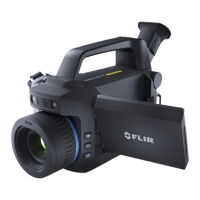Quantification
9
• Wind refers to the current wind conditions. There are three options: High (> 10 mph),
Normal (2-10 mph), and Low (0-1 mph). These general wind conditions are meant to
describe the dispersion qualities of the plume being measured. It is not necessary to
make an exact wind speed measurement, the setting is rather a description of the
general conditions.
• Leak type refers to the geometry of the leak. There are two options: Diffuse and Point.
A Diffuse leak is one whose source is greater than 5 cm (2 in.) in diameter. An exam-
ple of a diffuse leak is a thief hatch on a storage tank. A Point leak is one whose
source is less than 5 cm (2 in.) in diameter. An example of a Point leak is a fitting on a
¼" tubing.
• Distance refers to the distance from the camera to the leak.
• Gas type refers to the gas composition being measured.
• Gas plume refers to the polarity of the plume being measured. Considering white to
be hot, a Black plume will appear colder (or darker) than the background. It is typical
to have a Black plume when the apparent temperature of the background is warmer
than the ambient temperature. A White plume appears warmer (or brighter) than the
background. It is typical to have a White plume when the apparent temperature of the
background is colder than ambient temperature.
9.2.2 Type of measurement
The camera allows you to measure both flow rate and concentration. For more informa-
tion, see section 9.4.6 Leak rate versus concentration.
To select the type of measurement, do the following:
1. On the main toolbar, select Measurement. This displays a toolbar.
2. On the toolbar, do one of the following:
• Select Concentration. This displays a box on the image and a toolbar where you
can do the following:
◦ To resize the box, select Resize box and push the joystick. Move the joystick
up/down and left/right to resize the box.
◦ To move the box, select Move box and push the joystick. Move the joystick up/
down and left/right to move the box.
◦ To reset the box to default size and position, select Reset box.
◦ When completed, select Done.
• Select Flow rate. This displays a circle on the image.
9.2.2.1 Delta T
The background should be at least 2°C (3.6°F) warmer (or colder) than the ambient tem-
perature to provide sufficient contrast for quantification. Use the Delta T feature to show
areas of the field of view where there is insufficient delta temperature for quantification.
Those areas will be highlighted red.
For more information, see sections 9.3.6 Ensure minimum delta temperature and 9.4.3
Assessing delta temperature.
9.2.3 Flow rate unit
To change the flow rate unit, select Settings > Device settings > Language, time & units.
9.3 Perform a quantification measurement
In a typical field use, the camera will be used as a hand-held camera to first identify a
gas leak. To measure the leak, the operator will select a measurement position and place
the camera on a tripod and then perform a quantification measurement.
#T810605; r. AD/92464/92464; en-US
42

